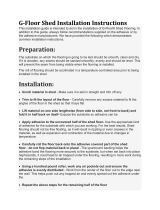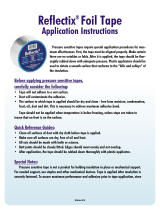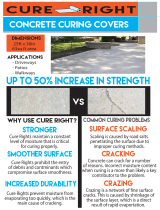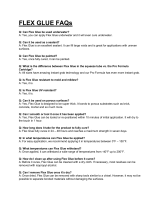
Double
Bond
Carpet
Installation
GUIDELINES & PROCEDURES

Excessive moisture and alkalinity can cause the degradation of adhesives and
flooring over time. A concrete substrate must exhibit alkalinity levels between 7 and
9 on the pH scale, moisture vapor emissions of no more than 3 lbs./24 hours/
1,000 sq. ft. (ASTM F1869 Calcium Chloride Test), and relative humidity levels
no more than 75 percent (ASTM F2170 In Situ Relative Humidity Test). Testing
protocols are available at www.astm.org.
Alkalinity – To check the alkalinity level of the concrete substrate, ensure all sealers
and curing compounds are removed, then wet the concrete with distilled water.
Allow the water to sit for two to three minutes. Carefully dip the pH testing paper in
the water and verify the alkalinity level of the slab. If the pH level exceeds 9, correct
the situation by rinsing with clean warm water and then allowing the slab to dry
thoroughly (typically 24 hours) before retesting.
DOUBLE BOND ADHESIVE GUIDELINES
Adhesive selection will depend upon the type of Double Bond installation method
specified. For a permanent bond,
Roberts 3095 Carpet Adhesive, 3300 Carpet &
Felt-Back Vinyl Adhesive or R3090 Carpet Adhesive may be used to adhere the
cushion to the substrate and the carpet to the cushion. However, some business
owners require a releasable cushion method, which allows fast removal and
reinstallation of the system and reduces costly business down time. For this type of
installation
Roberts R6300 or R6280 Pressure Sensitive Adhesive may be used to
install the cushion to the substrate due to their high performing pressure sensitive
characteristics.
Roberts 3095, 3300 or R3090 is then used to adhere the carpet to
the cushion.
Remember the glue line between the carpet and the cushion is subjected to high
stress flexing. Some high-end multipurpose adhesives are hard setting. The product
required for a Double Bond installation is a high-end, high solids and flexible
adhesive which maintains these characteristics.
It is imperative to use the correct amount of adhesive for Double Bond carpet
installations. Ensure that enough adhesive is applied in order to fully penetrate all
areas of the cushion and the carpet backing. Again, because the glue line is flexing,
the coverage of the adhesive to the flooring materials is paramount in order to
withstand the stress. A thin or insufficient amount of adhesive will cause debonding
and the ultimate failure of the installation, especially when submitted to extreme
wheel traffic. Note: The quantity of adhesive applied to both the substrate and the
cushion is more than that used during a direct bond installation.
Using the proper trowel and troweling technique is also imperative for ensuring
the correct amount of adhesive. Hold the trowel at a 45° angle, and when troweling
over the cushion, do not push so hard on the trowel that the cushion pushing into
the notches interferes with the adhesive application. Lift the cushion and carpet
corners occasionally to ensure sufficient coverage.
The open time will vary depending upon ambient temperature and humidity
conditions. Increasing air circulation with indirect air movers aimed at an angle
above the floor will shorten the open time. (Note: Ensure air movement is not
excessive. Excessive air movement will have the same affect as a strong wind and
will cause skinning of the adhesive which will not allow proper transfer of adhesive
to the backing of the carpet.) Also ensure air is clean and no dust is present. Dust
can settle on the surface of the adhesive and create an invisible layer, causing
imminent bond failure.
Disappearing Glue Syndrome – Adhesive may “disappear” when it is applied over a
cushion and the carpet is installed while the adhesive is still wet (rather than waiting
for the appropriate tack). Heavy traffic will cause the adhesive to be forced into the
recesses of the carpet backing and/or into the cushion (depending on the type of
cushion used) and laterally along the cushion. The glue line is then starved and
bond failure is imminent.
Use a lightweight roller (
Roberts 10-935 35 lb. Roller) to roll the installation. Using
a heavier roller can cause the adhesive to be pushed too far into the backing of
the carpet.
Eliminate or restrict traffic for 24 hours. Adhesives should be given the chance to
perform properly by using the correct amount of adhesive, allowing it to tack-up,
and also allowing it to cure. Subjecting a Double Bond installation to immediate
heavy traffic is extremely detrimental. If early traffic is unavoidable, use sheets of
plywood in those areas.
Failure to follow all of the above procedures will ultimately lead to a failed
installation.
1
INTRODUCTION TO DOUBLE BOND
Roberts Consolidated Industries is proud to be the pioneer of the Double Bond
carpet installation method. Over the years, the procedure for Double Bond carpet
installations has evolved, and this manual was developed to provide the most
up-to-date, comprehensive set of guidelines and procedures. Once mastered, these
techniques will make Double Bond as easy as direct bond installations…with higher
quality results.
•DoubleBondreferstoacarpetinstallationmethodofadheringcushion
to the substrate, and then adhering carpet to the cushion.
•Comparedtodirectbond,DoubleBondinstallationsaremore
comfortable, extend the carpet life, provide sound dampening qualities
and offer enhanced thermal insulation.
•TheDoubleBondmethoddevelopedbyRobertsisnowawidely
adopted and approved carpet installation method.
Standard recommended materials and techniques for the Double Bond method
have been accepted across the industry (although minor variations are advocated
by different manufacturers). The techniques are simple, but it is critical that they
be followed to the letter, to ensure the quality required for heavy traffic areas.
The guidelines and procedures contained in this manual should be followed
precisely – no shortcuts, no cheating, no substitutes, no excuses!
PREPARATION FOR DOUBLE BOND
CARPET INSTALLATIONS
CARPET, CUSHION & ADHESIVE CONDITIONS
Ensure substrate, carpet, cushion and adhesive are fully acclimated prior to
installation at the same temperature and humidity level expected during normal
use (between 65–95°F), with a relative humidity of no greater than 65%. Refer to
flooring manufacturer’s specific recommendations and industry standards. Note: If
the building is new or the HVAC has just been turned on, ensure the concrete slab is
at the correct temperature prior to installation. Maintain these conditions during and
after the installation. Large temperature or humidity changes after the installation
of the carpet will cause excessive expansion or contraction of the materials and/or
substrate and may cause installation failure.
The carpet should be unrolled and laid flat during acclimation. Ensure that the
carpet is not walked upon during the acclimation process. Check with the carpet
manufacturer to determine if they recommend precutting the carpet as well.
Subfloors must be structurally sound, dry, smooth, flat, level and free of excess
moisture/alkali and all substances that might interfere with the performance of the
adhesive bonding to the substrate or to the flooring installation itself. Remove all
the existing adhesive residues prior to installation. Due to the heavy traffic loads
and the increased stresses from the movement of the system it is critical that
the concrete substrate be clean in order for the adhesive to obtain the maximum
mechanical bond.
WARNING – Existing flooring and adhesives may contain asbestos. Unless you
have confirmation that the existing flooring system is not asbestos containing, do
not sand, dry sweep, dry scrape, abrade, drill, saw, bead blast, mechanically chip
or pulverize existing flooring or adhesive without taking all appropriate precautions.
Refer to local, provincial and federal guidelines for treatment and removal of
these products. You may also refer to the Resilient Floor Covering Institute’s
Recommended Work Practices for Removal of Resilient Floor Coverings.
All substrate cracks, holes, high spots and irregularities must be adequately
repaired to ensure a smooth, finished appearance to prevent show through and
accelerated wear. Patching compounds must be suitable for the use application,
cement based, polymer-modified and applied according to the manufacturer’s
instructions.
Refer to the Carpet and Rug Institute’s Carpet Installation Standard 2011, First
Edition (available at www.carpet-rug.org) for proper subfloor conditions. Inform
the builder and all interested parties of any negative conditions. When proper site
conditions are unattainable the installation should not proceed and if necessary
alternative installation methods should be considered.
INTRODUCTION TO DOUBLE BOND
PREPARATION FOR DOUBLE BOND
CARPET INSTALLATIONS

CUSHION REQUIREMENTS
The cushion in a Double Bond installation is subjected to much more stress than a
conventional stretch-in cushion. It is stressed not only vertically but also laterally
because it is glued top and bottom. The density and integrity of the cushion must
be such that it can withstand the additional stress. Further, the top and bottom of
the cushion must be both practical and suitable for bonding with trowelable latex
based adhesives. Please consult the cushion manufacturer to ensure they approve
the use of their cushion for Double Bond installation.
ADDITIONAL INSTALLATION NOTES
Always ensure adequate ventilation during flooring installation.
The trowel notches referenced in this manual are the minimum size normally
recommended. Surface conditions (roughness and porosity of substrate), type
of carpet/backing and cushion will ultimately determine the required trowel notch
size and coverage. Flooring manufacturer’s products differ in characteristics and
textures. Always check with the specific flooring manufacturer’s recommendations
for their specific trowel requirements. Less porous substrates typically require a
smaller notched trowel and longer open time than porous substrates. Worn trowels
should be thrown away. Re-notching trowels should not be attempted. Coverages
will vary depending upon the type of carpet, cushion and porosity of the substrate.
Ensure 100% transfer of adhesive.
Note: Trowel notches listed in this manual are measured: Width of Notch x Depth of
Notch x Notch Distance Apart.
Lack of adhesion caused either by the use of an unspecified adhesive, the
wrong notched trowel, not allowing the adhesive to tack-up prior to laying-in the
carpet, or by exposing the carpet to premature traffic, are the major causes of
failure in a Double Bond installation.
CUSHION-TO-FLOOR APPLICATION
1. Install the cushion in longest possible lengths, taking traffic patterns into
consideration. Ensure cushion seams are at a right angle to carpet seams. If that is
not possible, lay the cushion so the seams will offset at least 6 in. from the carpet
seams. Butt the seams of the cushion. Note: Do not tape or staple cushion seams
for Double Bond installations.
2. Trowel the recommended adhesive to the subfloor (see appropriate section
below for a permanent installation or releasable installation.)
PERMANENT CUSHION-TO-SUBSTRATE
INSTALLATION
• For Standard Subfloors and Cushions:
Adhesive: Roberts 3095 Carpet Adhesive or
3300 Carpet & Felt-Back Vinyl Adhesive or
R3090 Carpet Adhesive
Proper Trowel Size: 1/16 x 1/16 x 1/16 in., square-notch
(
Roberts 10-810, 10-823, 10125)
Approx. Coverage: 170–190 sq. ft. per gallon
• For Porous Subfloors and Cushions:
Adhesive: Roberts 3095 Carpet Adhesive or
3300 Carpet & Felt-Back Vinyl Adhesive or
R3090 Carpet Adhesive
Proper Trowel Size: 3/32 x 3/32 x 3/32 in., flat top V
(
Roberts 10-820, 10-833)
Approx. Coverage: 100–120 sq. ft. per gallon
2
RELEASABLE CUSHION-TO-SUBSTRATE
INSTALLATION
• For Standard Subfloors and Cushions:
Adhesive: Roberts R6300 or R6280 Pressure Sensitive Adhesive
Proper Trowel Size: 1/16 x 1/16 x 1/16 in., square-notch
(
Roberts 10-810, 10-823, 10125)
Approx. Coverage: 170–190 sq. ft. per gallon
• For Porous Subfloors and Cushions:
Adhesive: Roberts R6300 or R6280 Pressure Sensitive Adhesive
Proper Trowel Size: 3/32 x 3/32 x 3/32 in., flat top V
(
Roberts 10-820, 10-833)
Approx. Coverage: 100–120 sq. ft. per gallon
3. Respecting the open time of the adhesive, lay the cushion into the adhesive.
4. Smooth out any bubbles in the cushion and press the pad into the adhesive
using a tray, broom or a cardboard tube.
5. Trim the cushion flush to the wall.
CARPET-TO-CUSHION APPLICATION
All carpets should be dry laid at room temperatures between 65°F and 95°F and
acclimated for a minimum of 48 hours prior to installation.
1. Properly position the lengths of carpet, and then trim the seams. Refer to the
cushion and carpet manufacturer recommendations for proper seam sealing
and/or the use of seam tapes. If seam sealers are recommended by the carpet
manufacturer,
Roberts R5200 Carpet Seam Sealer or 8502 Carpet Latex or
8015 Universal Carpet Seam Sealer may be used to seal and protect the cut
carpet edges.
2. Fold the carpet back the same way as during a direct bond installation.
3. Trowel the recommended amount of adhesive onto the cushion (see carpet type
sections below). Do not spread adhesive underneath seaming tape. Respect the
open time of the adhesive. Note: Drying time will be extended during humid and
cold weather conditions and in areas of inadequate air circulation.
• For ActionBac
®
and Smooth Backed Carpets:
Adhesive: Roberts 3095 Carpet Adhesive or
3300 Carpet & Felt-Back Vinyl Adhesive or
R3090 Carpet Adhesive
Proper Trowel Size: 1/8 x 1/8 x 1/8 in., U-notch
Approx. Coverage: 65–75 sq. ft. per gallon
• For Woven and Other Heavily Textured Backings:
Adhesive: Roberts 3095 Carpet Adhesive or
3300 Carpet & Felt-Back Vinyl Adhesive or
R3090 Carpet Adhesive
Proper Trowel Size: 1/8 x 3/16 x 1/8 in., U-notch
Approx. Coverage: 35–55 sq. ft. per gallon
4. Lay the carpet into the adhesive after it becomes tacky, and complete the seam
by using a
Roberts Heat Bond Iron to melt the adhesive on the Double Bond heat
bond tape.
Important – The adhesive must begin to tack-up before the carpet is set in place. If
the adhesive is not allowed to tack-up, any weight or pressure applied to the carpet
will force the adhesive into the cushion or away from the pad and be absorbed by
the carpet’s backing. This action may produce the disappearing glue syndrome,
which results in a scarcity of adhesive at the critical points of contact of the carpet
and cushion. Bubbling of the carpet will result and the installation will ultimately fail.
5. Roll the carpet using a lightweight roller (
Roberts 10-935 35 lb. Roller).
CUSHION-TO-FLOOR APPLICATION
CARPET-TO-CUSHION APPLICATION

Carpet-to-Cushion Notes:
•Wovencarpetshouldberolledagain3–10hoursaftertheinitialrolling.
•Eliminateanybubblesbypressingstraightdownpriortofulladhesive
set up time. Do not roll bubbles to edge.
•Duetodimensionalinstability,DoubleBondinstallationofcarpetwith
a unitary backing is not recommended.
•Neverusearollerheavierthan35lbs.,asthiswilldrivetoomuchof
the adhesive into the pores of the pad and towards the edges of the
carpet, decreasing the strength of the bond in the middle of the floor
where the high traffic areas are.
•Youmustattaincompletecoverageandtransferofadhesivetothe
backing of the carpet in order for the installation to perform properly.
Using the proper trowel will help you to achieve this.
AFTER INSTALLATION
Maintain installation temperature for at least 30 days, and then the temperature
may be slowly readjusted as necessary while still remaining within the 65°F and
95°F temperature range. Large temperature or humidity changes after the instal-
lation of the carpet will cause excessive expansion or contraction of the materials
and/or substrate and may cause installation failure.
PROTECTION OF THE INSTALLATION
Wheel and foot traffic should be restricted for a minimum of 48 hours to allow the
adhesive to properly cure. Premature traffic WILL cause installation failure.
To protect the installation from dirt, paint, or additional work; cover the carpet with
a non-staining building material paper after the adhesive has cured. Never cover
the carpet with plastic sheeting as it will trap moisture and delay the curing of the
adhesive. If necessary, protect the installation from rolling traffic by putting down
sheets of plywood.
The use of protector pads under chairs with castors is mandatory.
CARPET MAINTENANCE
Important – Overwetting and use of chemicals with a 9.0 or higher pH level must
be avoided.
It is critical that the carpet not be exposed to water or cleaning agents during the
first 30 days. Ensure all cleaning products used are neutral pH.
ROBERTS DOES NOT RECOMMEND STEAM CLEANING Double Bond carpet instal-
lations, as this breaks down the latex in the adhesive, which could lead to an early
failure of an otherwise proper installation. Roberts recommends using dry systems
(such as Host
®
, Capture
®
or bonnet systems), which create a minimum wetting
action, as approved by the carpet manufacturer.
Roberts will not be held liable for failures resulting from improper carpet
maintenance procedures.
DOUBLE BOND INSTALLATION SUMMARY
•UseonlyRobertsrecommendedadhesivesandtrowels.
•MakesurethecarpetbackingandcushionaresuitableforaDouble
Bond application.
•Checkthesuboormoistureandalkalinitylevels.
•Cutandrolloutthecarpet48hourspriortotheinstallation.Allowthe
carpet and other materials to adapt to the site conditions.
•Ventilatethesiteduringandaftertheinstallation.
•Allowtheproperopentimeinorderfortheadhesivetodeveloptack.
This is essential in Double Bond installations.
•UseonlyanapprovedDoubleBondheatbondtapeatseams.Sealall
cut carpet edges with
Roberts R5200 Carpet Seam Sealer or 8502
Carpet Latex or Roberts 8015 Universal Carpet Seam Sealer.
•Eliminateanybubblesbypressingstraightdownpriortofulladhesive
set up time. Do not roll bubbles to edge.
•Allow48hoursofcuringtimebeforeallowingheavyfootor
wheel traffic.
•Nevercovertheinstallationwithplastic.
•Donotexposeinstallationtowaterorcleaningagentsforaminimum
of 30 days. Overwetting and use of chemicals with a 9.0 or higher pH
level must be avoided.
For installation questions that are not covered please contact our Technical
Services Department at (706) 277-5294.
See our Roberts Floor Covering Installation Tools Catalog for a complete listing of
our Roberts installation tools and accessories.
Quality & Excellence Since 1938.
www.ROBERTSCONSOLIDATED.com
AFTER INSTALLATION
DOUBLE BOND INSTALLATION SUMMARY
E1313-7071 May 2013
Roberts
®
is a registered trademark of Roberts Consolidated Industries, Inc.
ActionBac
®
is a registered trademark of Propex Operating Company, LLC
Host
®
is a registered trademark of Racine Industries
Capture
®
is a registered trademark of Milliken & Company
-
 1
1
-
 2
2
-
 3
3
-
 4
4
Roberts R6300-4 Installation guide
- Type
- Installation guide
- This manual is also suitable for
Ask a question and I''ll find the answer in the document
Finding information in a document is now easier with AI
Related papers
-
Roberts 3095-1 User manual
-
Roberts 2057-1 Installation guide
-
Roberts 4002-1 Installation guide
-
Roberts R6280-1 User manual
-
Roberts R6300-4 User guide
-
Roberts R8100-24 User manual
-
Roberts R1509-4-24P User manual
-
Roberts 8200-12 Installation guide
-
Roberts 2310-4 Installation guide
-
Roberts R1535-4 Installation guide
Other documents
-
Broan Standard Rug/Floor Tool UPC User manual
-
Future Foam 0554D-34-12 Installation guide
-
Loctite 908570 User guide
-
Everbilt 49885 Installation guide
-
 G-Floor SFW75DT8020MB Installation guide
G-Floor SFW75DT8020MB Installation guide
-
 Reflectix FT210 Installation guide
Reflectix FT210 Installation guide
-
 Cure-Right 70-100004 Installation guide
Cure-Right 70-100004 Installation guide
-
 FLEX SEAL FAMILY OF PRODUCTS GFSTANR06 User manual
FLEX SEAL FAMILY OF PRODUCTS GFSTANR06 User manual
-
Loctite 1652275 User manual
-
Loctite 1624417 User manual







